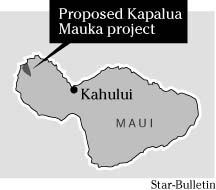
Permit for resort
in West Maui may
depend on diverting water
LAHAINA >> The Maui Planning Commission recommended approval of a 925-acre luxury resort project for West Maui but also recommended that the developer be required to restore some stream water it has been diverting for agriculture.
The recommendations were made Monday as Maui Land & Pineapple Inc., seeks approvals for its proposed Kapalua Mauka project. The issue goes before the Maui County Council for zoning and other land use considerations. No hearing date has been set.
Maui Land diverts water from a few streams to irrigate its pineapple fields and resort grounds and sends the remaining flow southward toward Lahaina, where it is used by other entities, including the county.
The company's plan to eventually withdraw from cultivation of pineapples in West Maui for canning played a role in the commission's recommendation to restore stream water at Honolua and Honokohau.
"I think there is water that could be put back in those streams," Commissioner Diane Shepherd said.
The proposed Kapalua Mauka, including 200 acres already a part of the Village Golf Course, would add about 50 percent more acreage to the 1,650-acre Kapalua resort community, owned by Maui Land & Pineapple.
About 169 acres of land within the project would be taken out of pineapple cultivation.
The firm plans to develop 690 single-family and multifamily homes and expand the mauka side of the Village Golf Course from 16 to 27 holes.
Construction of the homes is expected to cost an estimated $395 million, with prices for lots ranging from $500,000 to $1 million.
Robert McNatt, the firm's vice president for land planning, said he thinks it's impractical for his corporation to implement a stream-restoration program because his firm doesn't control all the water uses.
McNatt said while the corporation plans to withdraw from growing pineapple for canning in West Maui, it plans to cultivate some pineapple for its fresh fruit market and to lease former pineapple land for ranching and diversified farming.
McNatt said Kapalua Mauka's withdrawal of ditch water would be minor, about 200,000 gallons a day.
Maui Land official Warren Suzuki said those below the firm's diversion at Honokohau Stream get 3.3 million to 4.3 million gallons a day, including 2 to 3 million gallons a day from natural springs and 1 million gallons a day in diverted water for taro farming.
Wes Nohara, the plantation manager for Maui Pineapple Company Ltd., also owned by Maui Land & Pineapple, said stream flows at Honokohau can go up to 65 million gallons a day and at Honolua, up to 12 million gallons a day.
But he said the flows are about 10 to 12 million gallons a day about 85 percent of the time and that about 2.5 million gallons a day goes to the county for domestic use at Mahinahina.
Nohara said that at certain times in the past, there has been no water left after the withdrawal by the county.
During a meeting Monday night, several residents spoke in favor of increasing the flow in the streams.
Ann Fielding, a marine biologist, said increasing the flow would help to increase the amount of sea life, including fish such as mullet that rely upon fresh water nutrients in their growth cycle.
"The streams serve as an artery from the land to the sea," Fielding said.
In the early 1900s, stream flows at Honokohau and Honolua were diverted to irrigate sugarcane fields in west Maui.
Some of the diverted water eventually went toward developing the pineapple industry in west Maui.
